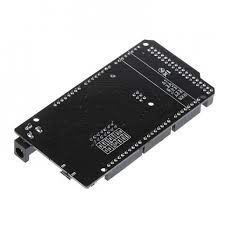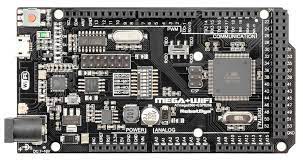Atmega328 + Esp8266 with Ch340
The perfect low cost IoT board with Arduino Mega R3 compatible design and onboard ESP8266 + 8Mb flash. WiFi board antenna and direct interface with ATmega2560. Programmable (both Arduino + ESP8266) using CH340G based USB to TTL interface which can also be used as a generic com port. Ideal solution for Network connected embedded computing applications..It is a customized version of the classic ARDUINO MEGA R3 board. Full integration of Atmel ATmega2560 microcontroller and ESP8266 Wi-Fi IC, with 32 Mb (megabits) of flash memory, and CH340G USB-TTL converter on a single board! All components can be set up to work together or independently.
This board is a custom version of the classic ARDUINO MEGA R3 board that integrates an Atmel ATmega2560 microcontroller, an ESP8266 Wi-Fi IC with 32 Mb (megabits) of flash memory, and a CH340G USB-TTL converter on one board. All of these modules can work together or separately, and each has its own pinout headers. This board is ideal for developing new projects that require both Uno and WiFi. You can update sketches and firmware for both ATmega328 and ESP8266 via USB.
This board has a DIP-switch that allows you to connect the modules in different ways. For example, you can connect USB and ATmega2560, USB and ESP8266, or ATmega2560 and ESP8266. The board uses the CH340G USB-serial converter for easy communication with your computer.
The operating mode is selected by means of DIP switches on-board:
Switch status and model selection:
| Connection↓/Switch No.→ | 1 | 2 | 3 | 4 | 5 | 6 | 7 | 8 |
| CH340 connect to ESP8266 (upload sketch) | OFF | OFF | OFF | OFF | ON | ON | ON | NoUSE |
| CH340 connect to ESP8266 (connect) | OFF | OFF | OFF | OFF | ON | ON | OFF | NoUSE |
| CH340 connect to ATmega2560 (upload sketch) | OFF | OFF | ON | ON | OFF | OFF | OFF | NoUSE |
| CH340 connect to Mega2560 COM3 connect to ESP8266 | ON | ON | ON | ON | OFF | OFF | OFF | NoUSE |
| Mega2560 ESP8266 | ON | ON | OFF | OFF | OFF | OFF | OFF | NoUSE |
| All modules work independently | OFF | OFF | OFF | OFF | OFF | OFF | OFF | NoUSE |
Also, have the switch to change of connecting port between ATmega2560 and ESP8266
After choosing the mode of the board can proceed to set up the IDE
It is important that when the ESP8266 module is programming, it is necessary to press the button “Mode”
| Power Output |
5V-800mA |
|---|---|
| Power Input USB |
5V (500mA max.) |
| Power Input VIN/DC Jack |
9-24v |
| Power Consumption |
5V 800mA |
| Operating temperature |
−40С°/+125С° |
| Memory Size |
256kb |






Reviews
Clear filtersThere are no reviews yet.